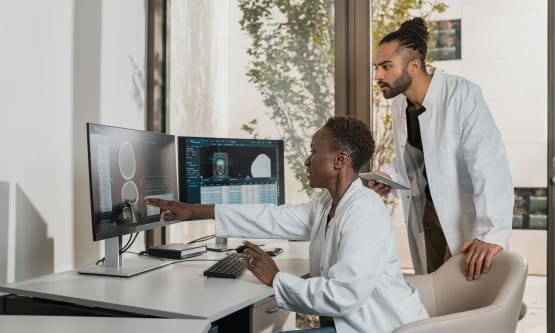Targetting cancer
- 1 June 2006
 Daloni Carlisle
Daloni Carlisle
Go to almost any cancer care department in an acute trust in England today and you will find a locally designed and implemented IT system to track each and every patient with an urgent GP referral.
You will find clinicians and data inputters working closely to identify which patients are on track to start their treatment within the target of 62 days from the urgent GP referral and which are blocked in the system and likely to breach.
These systems are one of the main reasons why the NHS is now close to achieving the government’s cancer waiting time target – that is, the time between a GP’s urgent referral for suspected cancer and starting treatment must not exceed 62 days for at least 95% of cancer patients.
That means seeing the patients in outpatients, organising and carrying out all the diagnostics and imaging, possibly referring to a tertiary centre, deciding which treatment to start and then getting on with it – all in two months.
Figures due out from the Department of Health in the first week in June are expected to show that the English NHS overall is just a few percentage points away, averaging around 91%. Beneath the headline figure, the data will show that numerous NHS trusts regularly hit the target; many of them in a sustainable way. More significantly, it will show an overall improvement of around 2% per month over the last five months of 2005/6.
Data collection
|
"It has meant knowing who your patients are as well as prospective data collection, so that you know where each patient is in relation to the target" — Cancer Tsar Professor Mike Richards
|
Cancer Tsar, Professor Mike Richards, says: "That’s a pretty remarkable achievement.’" He added that it was down to several factors, not least having good data.
"It has meant knowing who your patients are as well as prospective data collection, so that you know where each patient is in relation to the target and not just collected afterwards."
With prospective data collection, the multidisciplinary teams that manage patients can use something he calls ‘active navigation’ in which administrative staff follow patients’ progress, alerting the clinicians to any blockages so that they can be dealt with before a breach occurs.
This prospective data collection and tracking, together with redesigned clinical pathways that have tackled the traditional bottlenecks in diagnostics and outpatients, has delivered real change.
Nick Chapman, account manager at the Department of Health’s Recovery and Support Unit, has been instrumental in helping trusts develop their data systems.
"It was clear very early on that in a world where you need to move rapidly then retrospective data would not be of any use," he explained.
Constructing a new system
A year ago the only data most trusts had was collected on cancer waiting times system was hosted on the Open Exeter system. This tended to be incomplete and, in some cases, at least six weeks out of date.
Mr Chapman’s team looked at the experience of cutting elective waiting times which in many places has involved constructing ‘PTLs’.This acronym has a number of meanings, from ‘patient tracking list’ through to ‘priority target list’, but in essence it refers to a list of patients and dates by which they must be treated.
‘We set about getting people to construct a PTL for cancer patients,’ says Mr Chapman. ‘This meant a way of knowing where your patients are on their pathway in the kind of detail that enables you to spot patients who are going to start their treatment in 62 days and those that are going to present a problem. That essentially is the challenge we set all NHS organisations.’
The message that came back loud and clear was that hospital PASs would not deliver this level of detail. ‘None of the other mainline systems would do it either,’ adds Mr Chapman.
So most trusts designed their own systems. ‘In some cases it has been a local spreadsheet,’ says Mr Chapman. ‘There are some good commercial and NHS systems around. A few used pen and paper.’
With a system in place, trusts began to appoint dedicated patient trackers. Mr Chapman explains: ‘These are generally people who were previously doing the job of putting data into the cancer waits database. All of a sudden they are being closely involved in the multidisciplinary teams, chasing up the team’s actions, making sure Mrs Smith gets her CT scan by next Wednesday and that the results go back to the right discussion forum where the care can be planned. They became a critical lynchpin.’
That this is a pattern across England is confirmed by Janet Williamson, director of the Cancer Services Collaborative Improvement Partnership. For the last year the CSCIP has sponsored 28 demonstration sites and across the board they show the value of these local systems. A review of the lessons learnt is due to be published on the collaborative’s website in June.
"This is not information coming down from the management board," she says. "It works from the bottom up. It’s clinical teams understanding what’s happening on a daily basis."
Monitoring in action
|
"Our multidisciplinary teams will be able to have one screen up with all the patient information to make their decision and another screen with all the images. It will make a world of difference" — Martin Bell, IM&T director, North Bristol NHS Trust
|
At Good Hope Hospital in Birmingham the IT department helped develop a real-time monitoring system called CAMS (Cancer Active Monitoring System) based on the in-house patient workstation.
"It’s modelled on our four hour wait system," explains Dr Catherine Finn, clinical director for cancer services.
Patient details are colour coded depending on the length of time they have been in the system, allowing a visual check for those about the breach the target. It has an alert system when histology and radiology reports are available, prompting discussion at the next multidisciplinary team meeting. It even tracks patients when they go off site to another hospital for further investigations.
Nor are the systems static. In the Bristol health economy, where all three acute trusts use one system called the Bristol and Community Cancer System, there are now moves to integrate cancer monitoring with PACS.
North Bristol NHS Trust’s IM&T director, Martin Bell, says: "Our multidisciplinary teams will be able to have one screen up with all the patient information to make their decision and another screen with all the images. It will make a world of difference."
Future targets
All eyes are on the 62 day wait and the use it has made of IT and data to manage waiting times. This is not just because cancer matters. Nor is it because this is one of the key performance measures against which trusts will be assessed by the Healthcare Commission; full data reporting being the absolute minimum requirement.
Much of the interest is because this is the first so-called ‘end-to-end’ target that encompasses GP referral, diagnostics and treatment, perhaps in a tertiary centre. The next one is the 18-week target to treat all patients within 18 weeks of GP referral by 2008.
There are clear lessons. Mr Chapman says: "When it comes to the 18 week wait we now know that the role of information is critical. We know that the ability to navigate through pathways is critical."
But with cancer the numbers are on our side: even a busy hospital will have no more than 80 urgent referrals on the go at any one time and most will have only 25 to 30. With the 18-week wait, there could be thousands.
"We are going to have to design pathways that automatically deliver for the vast majority of patients,’ he adds. ‘Our information systems will have to be capable of picking up the tiny minority where things go wrong. We will be delivering active management at the margins."




